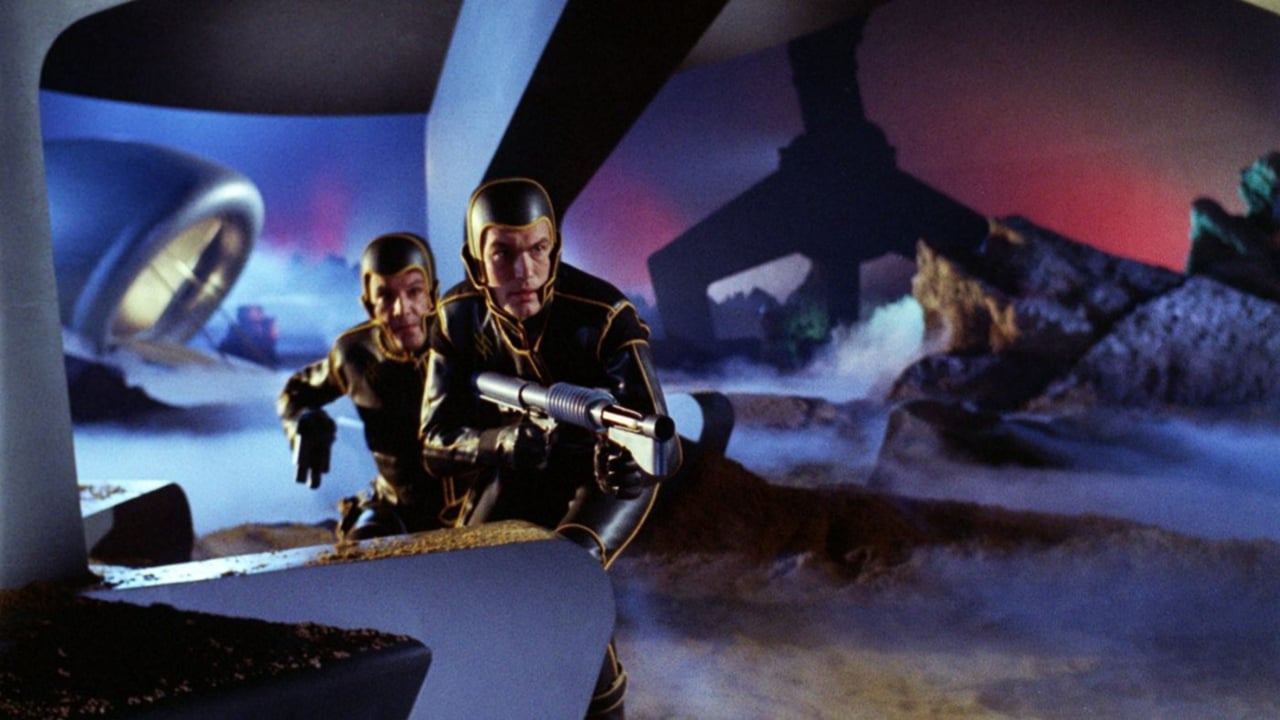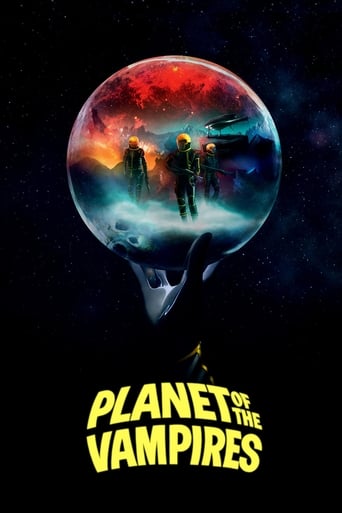SpuffyWeb
Sadly Over-hyped
YouHeart
I gave it a 7.5 out of 10
Twilightfa
Watch something else. There are very few redeeming qualities to this film.
Abegail Noëlle
While it is a pity that the story wasn't told with more visual finesse, this is trivial compared to our real-world problems. It takes a good movie to put that into perspective.
zardoz-13
"Planet of the Vampires" unfolds eerily enough after two sister spaceships—the Argos and Galliot—lose radio communication and find themselves drawn inexorably to the surface of the inscrutable planet Aura by a gravitational pull of 40 Gs that keeps both crews plastered helplessly to their winking and flashing consoles. Like the doomed crew in "Alien" who responded to a distress signal during their home-bound voyage, the ships in "Planet of the Vampire" have been listening to radio signals from the Aura for two years. Veteran western movie and television star Barry Sullivan of "Forty Guns" commands the spaceship Argos. As Captain Mark Markary, Sullivan manages to land the Argos down in one piece by reverting to strenuous manual control of the craft. The Argos successfully sets down on a rugged planet swathed in fog, a fate that their sister ship doesn't share. Captain Markary and his crew cannot fathom the sudden mayhem that awaits them after they have landed. No sooner have they touched than everybody is literally at each other's throats writhing in each other's death grips. Once Markary has intervened to restrain his eight-man crew, they decide to investigate and stumble onto a nightmare involving reanimated dead people who want to appropriate the spaceship that our heroes and heroines arrived in for their own dark purposes. Our heroes cannot lift off the planet because their solar batteries have been—in the words of a crew member—"short-circuited." They receive a help summons find the Galliot and discover the craft piled up with corpses that fought each other to the death, and they bury their comrades. Unfortunately, these kaput astronauts don't stay in their graves but rise from them, shred their polythene body bags and tangle with our heroes. Afterward, our band of intrepid space explorers tour the planet armed with their weapons. They come across the skeletal remains of other explorers in a gigantic ship, and they aren't happy that their sister ship crashed.Renowned "Black Sabbath" director Mario Bava conjured up this atmospheric chiller, adapted from Renato Pestriniero's short story "One Night of 21 Hours," long before Ridley Scott fielded international acclaim for his own superlative sci-fi/horror epic "Alien." If you watch this Italian/Spanish space opera simply to ridicule it for its inexpensive, low-budget special effects, then you are missing the point of everything. Produced frugally for about a hundred thousand dollars in U.S. currency in 1965, "Planet of the Vampires" delivers two major surprises at fade-out that you won't see coming because you have no way to prepare yourself from this ironic outcome. This is one of those early sci-fi films were evil asserts domination at the end. This "evil wins" scenario wasn't standard issue in most horror movies, aside from those celebrated franchises—such as the Universal Studios' classics Dracula, Frankenstein, Wolfman, Invisible Man, and Creature from the Black Lagoon. This cynical wrap-up is perfect for what is involved in this pictorially elegant but bargain basement special effects feature. Horror—like comedy—doesn't weather the sands of time as well as other genres to the test of time. The "vampires" in the title are nothing like the blood-sucking species in typical Hollywood pictures. Indeed, although the title is strikingly singular, Bava's film would have seemed better had it been entitled "Planet of the Zombies." "Planet of the Vampires" came out during the short-lived Spaghetti sci-fi craze in the earlier 1960s. Bava fans will appreciate the misty surroundings on planet Aura as well as the subdued red, white, green lighting. The entire film was lensed on soundstages at the legendary Cinecitta Studios in Rome, Italy. The scenes where the dead astronauts emerge from their improvised tombs on Aura is atmospheric. Bava has used slow-motion to make their re-emergence appropriately creepy. Giorgio Giovannini's set designs of the other spaceship with the colossal skeletons and the concentric circular doorways look cool. Gabriele Mayer's costume designs are nothing like what is usually seen in sci-fi films. The crew is decked out in black leather uniforms and their alternate apparel consists of interesting orange outfits.
tomgillespie2002
The crews of two giant interplanetary ships. the Galliott and the Argos, head to an unexplored planet shrouded in fog and mystery after intercepting a distress signal. When landing the two crafts lose contact with each other, and the Argos, lead by the experienced Captain Markary (Barry Sullivan), lands safely after some brief but heavy turbulence. Upon arrival, the crew of the Argos inexplicably attack each other, with only Markary able to resist the strange urge to kill. After they've been knocked out of their trance-like state, they travel to the nearby Galliott to find the entire crew either missing or dead. They bury the dead they find and set out to explore the vast wasteland, but Tiona (Evi Marandi) keeps having visions of the walking dead.Though far more experienced in horror, gialli and sword-and-sandal pictures, the great Mario Bava turns Planet of the Vampires into the most gorgeous sci-fi of its era. The planet, Aura, is desolate but strangely beautiful. Using bold primary colours and going overtime on a smoke machine, Bava infuses the planet with a suitably otherworldly atmosphere, which helps distract from the relatively formulaic plot. The director's love for horror can barely be contained as the crew start to rise from the dead. Placed in makeshift tombs and wrapped in a plastic sheet, they rise like blue- faced ghouls. Free from any distracting edits and backed by Gino Marinuzzi's eerie score, it is the most visually arresting moment in the film.It often gets cited as one of the inspirations for Ridley Scott's Alien (1979), though Scott and writer Dan O'Bannon claim to have never seen it prior to making the film. While Markary and his crew's discovery of giant humanoid skeletons does bring to mind the space jockey found in Scott's masterpiece, the two share little else in common. Behind the visual splendour, Planet of the Vampires suffers from a cheesy script and wooden acting, the common bane of the B- movie. Aside from an exciting set-piece involving an escape from a locked room having its oxygen sucked out, the film is actually quite plodding when it forces us to spend time with its collection of cut- out archetypes. Beautiful, certainly, and perhaps inspirational, but mark this amongst Bava's more mediocre efforts that are still worth checking out.
Claudio Carvalho
The spaceships Argos commanded by Captain Mark Markary (Barry Sullivan) and her sister Galliot commanded by Captain Sallas (Massimo Righi) travel to the mysterious planet Aura to investigate a strange transmission of a distress signal. The spaceships are protected by the meteor rejector instrument but on the arrival, the gravity increases and the automatic controls go haywire and the Galliot crashes on the surface of Aura. Then the crew-members in Argos go crazy and attack each other in a first moment. Soon Captain Mark finds that most of the crew from Argos is dead after fighting against each other. When the dead members resurrect, Captain Mark, communications officer Sanya (Norma Bengell) and engineer Wess (Ángel Aranda) discover that parasite bodiless aliens have entrapped them with the transmission expecting to flee from their dying world. What will be their attitude?"Terrore nello spazio", a.k.a. "Planet of the Vampires", despite the low- budget, is an original, stylish and with a surprising plot point. The conclusion shows a great surprise to the viewer. This movie was certainly the major influence to at least Ridley Scott's "Alien" and "Prometheus" that have similar storyline. It was said that the set was a Tower of Babel, with international cast using their own native language (Barry Sullivan, English; Norma Bengell, Portuguese; Ángel Aranda, Spanish; and Evi Marandi, English). My vote is seven.Title (Brazil): "O Planeta dos Vampiros" ("The Planet of the Vampires")
Scott LeBrun
Master filmmaker Mario Bava is working at the peak of his abilities with this sinister sci-fi / horror flick that surely had to have influenced "Alien" just as much as "It! The Terror from Beyond Space". The story (the English language version was co-adapted by noted writer Ib Melchior, based on a tale by Renato Pestriniero) sees a group of astronauts investigating signals sent from a distant planet. They're forced to land, where a strange presence influences their minds and turns them against each other. Not only that, but these aliens are able to resurrect the bodies of the human dead.As fans of Bava come to expect, everything is very stylishly done. The atmosphere is overwhelming, the fog machine works overtime, the sets are incredible, and the use of colour is impeccable. It does actually feel like these characters could be on another planet. There's a little bit of gore along the way to spice things up. Even the costumes are stylized; dig the ridiculous size of those collars! The eerie music is by Gino Marinuzzi Jr. Bava creates a palpable sense of doom and gloom, and the story builds to an effective twist ending.The actors are all fine, with veteran Barry Sullivan ("The Bad and the Beautiful") assuming the role of the intrepid captain. Lovely ladies Norma Bengell and Evi Marandi play Sanya and Tiona, respectively. Angel Aranda plays the part of crew member Wess, and busy horror & exploitation star Ivan Rassimov ("The Man from the Deep River") has dual roles.If you're an admirer of "Alien", then you really should check out this suspenseful little gem that preceded it.Eight out of 10.

